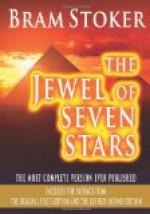“In the Chamber of the sarcophagus were pictures and writings to show that she had achieved victory over Sleep. Indeed, there was everywhere a symbolism, wonderful even in a land and an age of symbolism. Prominence was given to the fact that she, though a Queen, claimed all the privileges of kingship and masculinity. In one place she was pictured in man’s dress, and wearing the White and Red Crowns. In the following picture she was in female dress, but still wearing the Crowns of Upper and Lower Egypt, while the discarded male raiment lay at her feet. In every picture where hope, or aim, of resurrection was expressed there was the added symbol of the North; and in many places— always in representations of important events, past, present, or future—was a grouping of the stars of the Plough. She evidently regarded this constellation as in some way peculiarly associated with herself.
“Perhaps the most remarkable statement in the records, both on the Stele and in the mural writings, was that Queen Tera had power to compel the Gods. This, by the way, was not an isolated belief in Egyptian history; but was different in its cause. She had engraved on a ruby, carved like a scarab, and having seven stars of seven points, Master Words to compel all the Gods, both of the Upper and the Under Worlds.
“In the statement it was plainly set forth that the hatred of the priests was, she knew, stored up for her, and that they would after her death try to suppress her name. This was a terrible revenge, I may tell you, in Egyptian mythology; for without a name no one can after death be introduced to the Gods, or have prayers said for him. Therefore, she had intended her resurrection to be after a long time and in a more northern land, under the constellation whose seven stars had ruled her birth. To this end, her hand was to be in the air—’unwrapped’—and in it the Jewel of Seven Stars, so that wherever there was air she might move even as her Ka could move! This, after thinking it over, Mr. Trelawny and I agreed meant that her body could become astral at command, and so move, particle by particle, and become whole again when and where required. Then there was a piece of writing in which allusion was made to a chest or casket in which were contained all the Gods, and Will, and Sleep, the two latter being personified by symbols. The box was mentioned as with seven sides. It was not much of a surprise to us when, underneath the feet of the mummy, we found the seven-sided casket, which you have also seen in Mr. Trelawny’s room. On the underneath part of the wrapping— linen of the left foot was painted, in the same vermilion colour as that used in the Stele, the hieroglyphic symbol for much water, and underneath the right foot the symbol of the earth. We made out the symbolism to be that her body, immortal and transferable at will, ruled both the land and water, air and fire—the latter being exemplified by the light of the Jewel Stone, and further by the flint and iron which lay outside the mummy wrappings.




